In detail: do-it-yourself repair of interskol memory from a real master for the site my.housecope.com.
The power section of the screwdriver charger is a power transformer of the GS-1415 type, designed for a power of 25 watts.
A reduced alternating voltage of 18V is removed from the secondary winding of the transformer, it follows on diode bridge of 4 diodes VD1-VD4 type 1N5408, through a fuse. Diode bridge . Each 1N5408 semiconductor element is rated for forward currents up to three amperes. The electrolytic capacitance C1 smooths out the ripple that appears in the circuit after the diode bridge.
Management is implemented on a micro-assembly HCF4060BE, which combines a 14-bit counter with oscillator components. It drives a bipolar transistor type S9012. It is loaded on a relay type S3-12A. Thus, a timer is schematically implemented, which turns on the relay for a time of charging the battery for about an hour. When the charger is turned on and the battery is connected, the relay contacts are in the normally open position. The HCF4060BE receives power through a 12 volt 1N4742A zener diode, because about 24 volts comes from the rectifier output.
When the "Start" button is closed, the voltage from the rectifier begins to follow to the zener diode through the resistance R6, then the stabilized voltage goes to the 16th pin of U1. The transistor S9012, which is controlled by the HCF4060BE, turns on. The voltage across the open junctions of the S9012 transistor follows the relay coil. The contacts of the latter are closed, and the battery begins to charge. The protective diode VD8 (1N4007) bypasses the relay and protects VT from a reverse voltage surge that occurs when the relay winding is de-energized. VD5 prevents the battery from discharging when the mains voltage is disconnected. With the opening of the contacts of the "Start" button, nothing will happen, because the power goes through the diode VD7 (1N4007), the Zener diode VD6 and the quenching resistor R6. Therefore, the microcircuit will receive power even after the button is released.
| Video (click to play). |
Replaceable typical battery from the power tool is assembled from separate series-connected nickel-cadmium Ni-Cd batteries, each 1.2 volts, so there are 12 of them. The total voltage of such a battery will be about 14.4 volts. In addition, a temperature sensor has been added to the battery pack - SA1 it is glued to one of the Ni-Cd batteries and fits snugly to it. One of the terminals of the thermostat is connected to the minus of the storage battery. The second pin is connected to a separate, third connector.
When the “Start” button is pressed, the relay closes its contacts, and the battery charging process begins. The red LED lights up. An hour later, the relay with its contacts breaks the battery charge circuit of the screwdriver. The green LED turns on and the red one goes out.
A thermal contact monitors the temperature of the battery and breaks the charging circuit if the temperature is above 45 °. If this happens before the timer circuit runs out, this indicates the presence of a "memory effect".
Over time, due to wear and tear, the "Start" button works buggy, and sometimes does not work at all. Also in my practice, the 1N4742A zener diode and HCF4060BE microcircuits took off. If the charger circuit is working properly and does not arouse suspicion, and the charge does not start, then it is necessary to check the thermal switch in the battery pack, carefully disassembling it.
The design is based on an adjustable positive voltage regulator. It allows work with a load current of up to 1.5A, which is quite enough to charge the batteries.
Alternating voltage of 13V, is removed from the secondary winding of the transformer, rectified by a diode bridge D3SBA40.At its output there is a filtering capacitor C1, which reduces the ripple of the rectified voltage. From the rectifier, a constant voltage is supplied to an integral stabilizer, the output voltage of which is set by the resistance of the resistor R4 at 14.1V (Depends on the type of battery of the screwdriver). The charging current sensor is the resistance R3, in parallel to which the trimmer R2 is connected, with the help of this resistance the level of the charging current is set, which corresponds to 0.1 of the battery capacity. At the first stage, the battery is charged with a stable current, then when the charging current becomes less than the limiting current value, the battery will be charged with a lower current to the stabilization voltage DA1.
The charging current sensor for the HL1 LED is VD2. In this case, HL1 will indicate a current of up to 50 milliamperes. If R3 is used as a current sensor, then the LED will go out at a current of 0.6A, which would be too early. The battery would not have had time to charge. This device can also be used with 6-volt batteries.
The radio amateur design is used to discharge and charge NiCd batteries with a capacity of 1.2 A * h. At its core, it is an improved typical screwdriver charger, in which a circuit is introduced that controls the additional discharge and subsequent battery charge. After connecting the battery to the charger, the process of discharging the battery with a current of 120 mA to a voltage of 10 V starts, then the battery starts charging with a current of 400 mA. The charge stops when the voltage on the screwdriver battery reaches 15.2 V or by timer after 3.5 hours (programmed in the MK firmware).
When discharged, HL1 is constantly on. During the charging process, the HL2 LED is on and the HL1 blinks at intervals of once every 5 seconds. After the end of the battery charge, upon reaching the upper voltage level, HL1 starts blinking rapidly (2 blinks with a pause of 600 ms). If the charge is interrupted by the timer, then HL1 blinks once every 600 ms. If the supply voltage has disappeared during the charging process, the timer will stop. And the PIC12F675 microcontroller receives power from the battery, through a diode, inside the transistor VT2. Firmware for MK on the link above.
Added by (24.04.2017, 05:47)
———————————————
The zener diode on the optocoupler produces 1.1 volts. This is as far as I understand the normal voltage for this circuit.
Added by (24.04.2017, 05:51)
———————————————
There is no marking on the zener diode. Can anyone have a diagram? The charger is without a relay, there is a logic chip of the 7040 series, if I am not mistaken (there is no marking on it).
Added by (24.04.2017, 12:19)
———————————————
well, and so offhand the zener diode we turn on end-to-end to the power source, to the cathode + to the anode -
Added by (24.04.2017, 19:52)
———————————————
Zener diode replaced. The old one rang, was also a worker. The transistor replaced smd, cut off the road. The result is the same 1.1 volts. There are no more zener diodes in the circuit, according to the designation on the board.
There is something else to check besides the zener diode.
First, check the open circuit R15-R17, RJ1.
Added by (25.04.2017, 23:46)
———————————————
Good night. I checked the resistors for an open circuit, they showed 0.6 ohms on the board. I dropped it and checked it, they work fine, the resistance is the same as in the 1.6 ohm scheme. What kind of microcircuit u1 63E511, who knows? Datashit on her in the internet was not found. What is she responsible for?
Added by (25.04.2017, 23:49)
———————————————
I ask you not to condemn me strictly because I have never encountered pulse devices before. Therefore, I ask you for help.
Added by (07.05.2017, 19:53)
———————————————
Good evening. Finally there was time to write the result of my labors and your help. The charger revived, replaced the Q9 transistor. And everything began to work. True, Akum does not receive food from 14.4 now, but only 8.
Before starting repair work, you need to get acquainted with the design of this tool and identify elements, which will be required to fix the screwdriver, among them:
The contact placed on the button will move along the board, taking into account the pressure on the button. The level of the impulse applied to the key depends on the location of the element. The key is a field-effect transistor. The principle of operation will be as follows: the harder you press the button, the higher the value of the pulse on the transistor and the greater the voltage on the motor.
Motor rotation is reversed by reversing the polarity at the terminals. This process takes place using contacts that are switched using a reversing handle.
As a rule, screwdrivers contain collector single-phase DC motors. They are quite reliable and very easy to maintain. Standard screwdriver consists of the following elements:
The gearing system converts the high rotations of the motor shaft into the rotations of the chuck. Screwdrivers use classic or planetary gearboxes. The first ones are installed very rarely. Planetary gearboxes consist of the following parts:
- sun gear;
- ring gear;
- drove;
- satellites.
The sun gear works by means of the armature shaft, its teeth activate the satellites that rotate the carrier.
A special regulator is installed to regulate the force with which it is supplied to the screw. Typically, there are 15 adjustment positions.
The main signs of breakage spare parts in this case are:
- impossibility of adjusting the number of revolutions;
- impossibility of switching to reverse mode;
- breakdown of the charger;
- the screwdriver does not turn on.
First you need to check the tool battery. If the screwdriver was set to charge, but this did not give results, then you need to prepare a multimeter and try to determine the breakdown with it.
First you need to measure the voltage value of the battery. This value must correspond approximately to that which is written on the case. If the voltage is low, then you need to identify the faulty part: the charger or the battery. What do you need a multimeter for? We plug this device into the network, then we measure the voltage at the terminals idling. It must be several volts higher than indicated on the design. If there is no voltage, then the charger needs to be repaired.
As a rule, all chargers, like most spare parts, are not original, and they are manufactured not in Germany or Switzerland, but in China... But there is nothing wrong with that, the quality usually corresponds to the standard.
BOSH connector is three-pin: one control connector and two power connectors.
Most often, this situation appears - the battery is installed in charging - but the charging process ends in just a few minutes, and the battery is discharged, and the charger stops.
To understand the problem and find the faulty part, you need to disassemble the charger.We unscrew the four screws at the bottom and open the case. In the case, in one compartment there is an AC voltage transformer, and in the other - a rectifier circuit with power connectors and a control chip.
Then we plug in the charger and we measure the current strength on the transformer - if everything is fine, then proceed to the next procedure.
You don't need to touch the control chip and rectifier, they are most likely fine. We pass to the contact group - one control contact and two power contacts. To determine what the malfunction may be, we need to measure the current at the power terminals when the charge is working. Why do we solder to all contacts along a thin wire - so that the voltage can be measured when charging is working.
It is advisable to use several colors of wires in this scheme and, accordingly, to solder them plus and minus. Then we collect the charging and test with a multimeter the current at the terminals when charging.
If the current on the device is unstable and fluctuates in the range from 3-4 to 14-18 volts. Moreover, if you move the battery, then the contact disappears. It is here that the reason lies - during the operation of the device - the terminals are bent and poor contact leads to unstable charging of the screwdriver battery.
That is, it is clear that unstable contact breaks the charging logic - in particular, the third contact, control, it is he who is responsible for what current is supplied to the terminals. It will not be possible to close it, since there is a thermistor inside the circuit of any battery and its resistance changes taking into account the temperature of the spare parts inside the battery. That's right, it protects the battery from overheating and overcharging at the same time. But in this case, there is a way out. We again disassemble the charging, bend the terminals, then use a multimeter to watch the charging process - the current at the terminals will slowly increase and then decrease, and the indicator light on the charging is an additional indicator of operation.
The rate of growth of the current at the terminals indicates another important factor - battery wear. If the current rises very quickly and reaches 18-19 volts, then the battery is in good condition. When the battery is slowly taking charge, there is a high probability that some part of the battery is already unusable and needs to be replaced.
Thus, after the restoration of contact between the charger and the battery, we see normal charging process... If the charging seat is loose, then you need to fix the battery in the desired position with electrical tape. The wires that were soldered for indication, we advise you to leave them with the help of them, it is very easy to determine which spare part is faulty, the battery or charging.
If the charger and the battery are in good order, but the screwdriver still does not work, then you need to disassemble this device. Several wires come out from the battery terminals, you need to take a multimeter and measure the current at the input of the button... If it is present, then you need to get the battery, using the clamps, short-circuit the wires from it. The multimeter should determine the resistance, which should tend to zero. In this case, the spare part is working properly, the problem is with the brushes or other elements. If the resistance is different, then the button will need to be changed. To repair the button, sometimes it is enough to clean the contacts on the terminals with sandpaper. You also need to check the reverse spare part. Repair takes place by cleaning the contacts.
Mechanical breakdowns defined in this way:
- The screwdriver vibrates a lot during operation.
- During operation, the screwdriver emits extraneous noise.
- The screwdriver turns on, but it does not work because of jamming.
- Hits the chuck.
If during operation the screwdriver emits extraneous noise, this means that the bearing or bushings are worn out. To fix this, you need to disassemble the engine, then check the wear level of the bushing and the integrity of the bearing. The anchor must spin freely, there should not be any distortions or friction. These accessories can be purchased at the store and replaced with your own hands.
To the most common malfunctions gearbox designs include the following:
- break in the pin where the satellite is attached;
- abrasion of gears;
- shaft malfunction.
In all cases, it is necessary to replace the defective spare part of the gearbox. All the actions described above must be performed very carefully. Disassembly of the screwdriver must be done in a clear sequence, since some of the spare parts may be lost. Anyone can make an independent repair of a screwdriver, you just need to correctly identify the broken part.
Currently producing 12-18 V models... It is also worth noting that manufacturers use different components for different charger models. To figure this out, you should familiarize yourself with the standard circuit diagram for these chargers.
The basis of the standard scheme is three-channel type microcircuit... In this version, four transistors are attached to the microcircuit, very different in capacitance and high-frequency capacitors (pulse or transient). To stabilize the current, thyristors or open-type tetrodes are used. The current conductivity is regulated by dipole filters. This circuitry handles network overloads with ease.
The purpose of power tools is primarily to make our daily work less tedious and chore. In the home, a screwdriver is an indispensable assistant in the repair or disassembly (assembly) of furniture and other household items. Autonomous power supply screwdriver makes it more mobile and convenient to use. The charger is a power source for any cordless power tool, including a screwdriver. For example, let's get acquainted with the device and the schematic diagram.
For circuit diagrams of chargers for 18 V screwdrivers, transistors several capacitors and a diode bridge tetrode. Frequency stabilization is carried out by the grid trigger. Charging current conductivity for 18 V is 5.4 μA. Sometimes, chromatic resistors are used to improve conductivity. The capacitance of the capacitors, in this case, should not be higher than 15 pF.
The "banks" of the battery are enclosed in a housing that has four contacts, including two power plus and minus for discharge / charge. Upper control contact switched on via thermistor (thermal sensor) that protects the battery from overheating while charging. When it gets too hot, it limits or cuts off the charging current.The service contact is connected through a 9 kOhm resistor, which equalizes the charge of all elements of complex charging stations, but they are usually used for industrial devices.
Interskol chargers use transceivers with increased conductivity. Their maximum current load reaches 6 A, and even higher in new models. The standard charger of the Interskol screwdriver uses a two-channel microcircuit, 3 pF capacitors, pulse transistors and open-type tetrodes. The current conductivity reaches 6 μA, with an average battery capacity of 12 mAh.
- Quite often, the Russian manufacturer Interskol uses a battery charging circuit with IRLML 2230 transistors. In this case, a three-channel microcircuit and capacitors with a capacity of 2 pF are used in 18 V chargers, which are well tolerated by network loads. The conductivity index in this case reaches 4 μA. When choosing a screwdriver, you need to take into account its power, which affects its service life. The higher the power rating, the longer the tool will last.
The battery is the most expensive part of a screwdriver and is approximately 70% of the total cost tool. If it fails, you will have to spend money on purchasing a practically new screwdriver. But if you have certain skills and knowledge, you can fix the breakdown yourself. This requires certain knowledge about the features and structure of a battery or charger.
All elements of a screwdriver, as a rule, have standard characteristics and dimensions. Their main difference is the value of energy consumption, which is measured in A / h (ampere / hour). The capacity is indicated on each element of the power supply (they are called "banks").
"Banks" are: lithium - ionic, nickel - cadmium and nickel - metal - hydride. The voltage of the first type is 3.6 V, others have a voltage of 1.2 V.
Battery malfunction determined by a multimeter. He will determine which of the "cans" is out of order.
To repair a screwdriver battery, you need to know its design and accurately determine the location of the breakdown and the malfunction itself. If even one element fails, the entire circuit will lose its functionality. The presence of a "donor" in which all the elements are in order or new "banks" will help solve this problem.
A multimeter or 12 V lamp will tell you which item is faulty. To do this, you need to put the battery to charge until it is fully charged. Then disassemble the case and measure voltage all elements of the chain. If the voltage of the "cans" is lower than the nominal, then you need to mark them with a marker. Then collect the battery and let it run until its power drops noticeably. After that, disassemble again and measure the voltage of the marked "cans". The voltage sag on these should be most noticeable. If the difference is 0.5 V or more, and the element is working, then this indicates its imminent failure. Such elements must be replaced.
Using a 12 V lamp, you can also identify faulty circuit elements. To do this, connect a fully charged and disassembled battery to the plus and minus contacts on the 12V lamp. The load created by the lamp will be discharge the battery... Then measure the sections of the chain and identify the faulty links. Repair (restoration or replacement) can be done in two ways.
- The defective element is cut off and a new one is soldered with a soldering iron. This applies to lithium ion batteries. Since it is not possible to restore their work.
- Nickel - cadmium and nickel - metal - hydride cells can be recovered if an electrolyte is present that has lost volume. To do this, they are stitched with voltage, as well as enhanced current, which helps to eliminate the memory effect and increases the capacity of the element. Although it will not be possible to completely eliminate the defect.Perhaps, after a while, the malfunction will return. A much better option would be to replace the failed elements.
To repair a battery for a screwdriver, you will need spare battery, from which, you can borrow the necessary parts or purchase new chain elements. New "banks" must meet the required parameters. To replace them, you will need a soldering iron, tin, rosin, or flux.
Unsolder the connections of the defective parts and replace them with new ones. At the same time, do not allow them to overheat, which can damage the battery. To do this, try to perform quick soldering without delay. In the process of soldering, you can cool it with a touch of your hand, with the voltage disconnected.
- Make the connections with native plates (maybe copper ones), otherwise overheating of the wires can trigger the necessary thermistor, which controls the heating and turns off the charging system. Remember to observe the polarity when connecting. The minus of the previous element, when connected in series, is attached to the plus of the next one.
- Equalize the potential of the circuit elements. It differs in almost all "banks". To do this, put the battery to charge overnight, and then leave it to cool down for a day. Then, measure the voltage of the cells. Indicators should be very close to par.
- Insert the battery into the screwdriver and give it the maximum load until it is completely discharged. Do two full discharge cycles. The result will give a complete picture of the effectiveness of the repair work.
To charge the battery device, you can make a homemade charger, USB powered... Required components for this: socket, USB charger, 10 amp fuse, necessary connectors, paint, electrical tape and tape. For this you need:
Disassemble the screwdriver into parts and cut off the upper body from the handle with a knife.
- Make a hole for the fuse to the side of the handle. Connect the cable with the fuse and fit into the handle of the unit.
- Fix the fuse with glue or a heat gun. Wrap the case with tape and attach the structure to the battery connector. The wires are mounted at the top of the screwdriver. The tool is assembled and wrapped with electrical tape. After that, the body is sanded, covered with paint and the resulting device is charged.
As you can see, this the process will not take long and won't be too ruinous for your family budget.

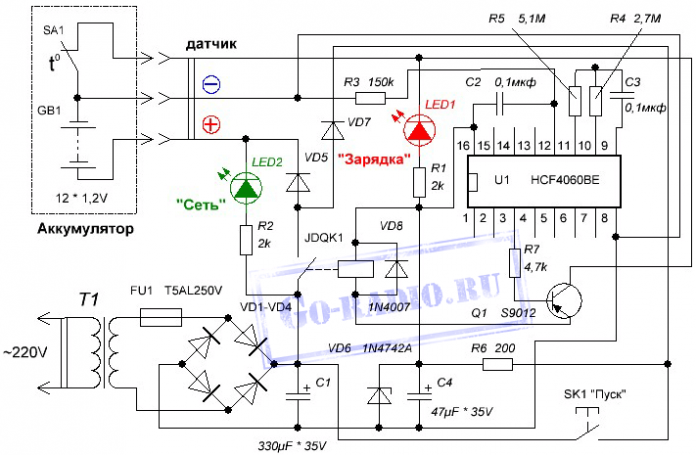

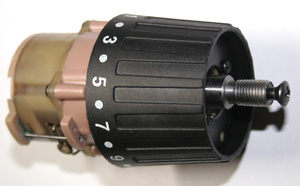

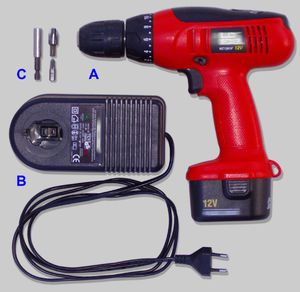
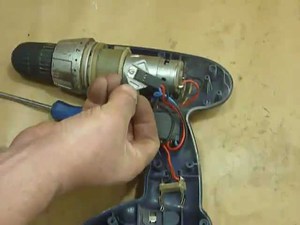
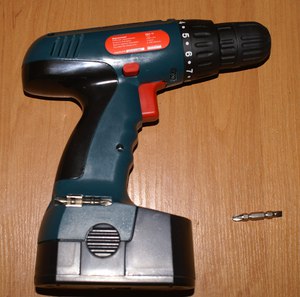
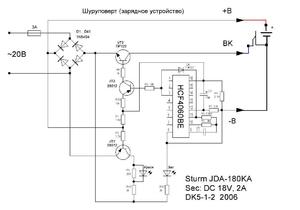
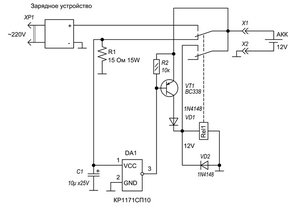 Interskol chargers use transceivers with increased conductivity. Their maximum current load reaches 6 A, and even higher in new models. The standard charger of the Interskol screwdriver uses a two-channel microcircuit, 3 pF capacitors, pulse transistors and open-type tetrodes. The current conductivity reaches 6 μA, with an average battery capacity of 12 mAh.
Interskol chargers use transceivers with increased conductivity. Their maximum current load reaches 6 A, and even higher in new models. The standard charger of the Interskol screwdriver uses a two-channel microcircuit, 3 pF capacitors, pulse transistors and open-type tetrodes. The current conductivity reaches 6 μA, with an average battery capacity of 12 mAh.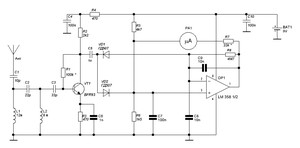 Unsolder the connections of the defective parts and replace them with new ones. At the same time, do not allow them to overheat, which can damage the battery. To do this, try to perform quick soldering without delay. In the process of soldering, you can cool it with a touch of your hand, with the voltage disconnected.
Unsolder the connections of the defective parts and replace them with new ones. At the same time, do not allow them to overheat, which can damage the battery. To do this, try to perform quick soldering without delay. In the process of soldering, you can cool it with a touch of your hand, with the voltage disconnected.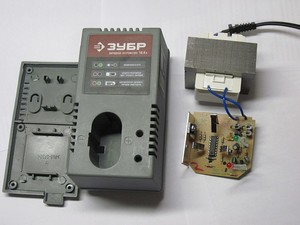 Disassemble the screwdriver into parts and cut off the upper body from the handle with a knife.
Disassemble the screwdriver into parts and cut off the upper body from the handle with a knife.